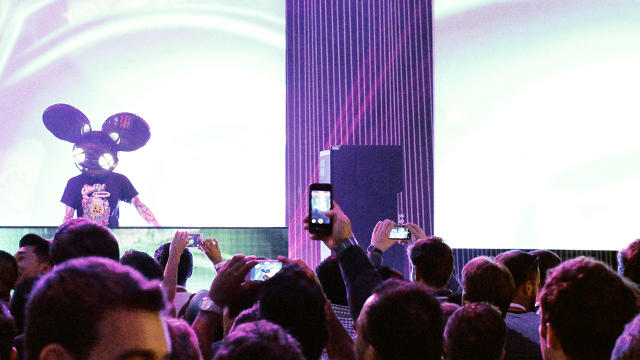Spotify, Tidal, Taylor Swift, And The Coming Streaming Music Wars
The battle for listeners is about much more than one star’s catalog.
Once upon a time, on-demand, unlimited streaming access to a huge catalog of music for a monthly fee was an amazingly exciting idea, and Rhapsody was the only company doing it. Now services like Spotify and Deezer have dominated what’s become a common category.
So where does streaming go from here?
Spotify said recently that it had 60 million global users of its on-demand streaming music service—15 million of whom were paying for an ad-free, mobile experience. While awareness of streaming music is clearly increasing, it’s far from mainstream adoption when one of the most popular services only has a fraction of the U.S. population using it.
Looking ahead, it’s nearly inevitable that on-demand streaming will catch on. And in speaking with some of Fast Company’s Most Innovative Companies in music about what they see coming over the next five years, we can peek at the future of music streaming—and beyond.
Users Unite
Even though it’s not clear how long it will take the majority of people to subscribe to an on-demand streaming music service, it’s almost certain to catch on. It’s coming—record labels want people renting their music, and consumers want access to it all.
“I think the labels are smartly focusing on ‘mainstreaming’ streaming [music], and when streaming apps come bundled on phones with free trials and easy upgrade, the convenience and value to consumers will win the day,” says Alex White, cofounder of Next Big Sound.
And while there are grumblings in the industry—such as Universal Music wanting Spotify to shut down its free streaming tier—the cofounder of Bop.FM, Shehzad Daredia, sees the freemium model as something that will continue to grow over the years.
“Freemium, or ad-supported models, will gain traction beyond just Spotify, which is critical for mainstream adoption,” he says. “Supporting this will be the trend for advertising to become higher return on investment as richer data is used for more granular targeting.”
It seems unlikely that these new music services can convince the average consumer who spent $64 a year on music in the days of CDs, to pay $10 per month without first getting hooked. And Rdio has also transitioned to an ad-supported model on the web, allowing users to freely stream anything with occasional ad breaks. The ad-supported model is something a lot of companies agree will grow or be a part of streaming music’s future.
Deals, Windows, And Exclusives
Once you have a majority of people hooked and either paying a monthly fee or generating ad revenue from listening, what becomes the battleground? Spotify may hold the answer to this question. To wit: Taylor Swift took her music off the service and is now offering the latest release, 1989, on Tidal, the Jay Z-owned streaming service promoting its artist owners. (Correction: Swift’s latest album, 1989, is not available on Tidal. Her back catalog, however, is available there and on other streaming platforms that do not offer a freemium service.)
When Swift left Spotify, she articulated the feelings of many musicians, from the super-popular to the hardcore indie:
If I had streamed the new album, it’s impossible to try to speculate what would have happened. But all I can say is that music is changing so quickly, and the landscape of the music industry itself is changing so quickly, that everything new, like Spotify, all feels to me a bit like a grand experiment.
Swift is not the only major celeb lining up behind Jay Z: Kanye West, Rihanna, Coldplay, Madonna, Alicia Keys, and, naturally, Beyoncé all supported the cause at a recent press conference about Tidal’s new look. And, according to The Guardian, “Under Jay Z, Tidal’s strategy will include encouraging artists to lobby their labels to ‘window’ new releases for at least a week, meaning they will be exclusive to Tidal for that period.”
The thing that execs from Bop.fm, Next Big Sound, and Deezer all agreed on is that windowing, or gaining exclusive content for specific services, will heat up tremendously. Once the mainstream is comfortable with the streaming music model, it becomes primarily about content as a way to differentiate one service from another.
For a hint of what’s to come, consider the mobile-phone industry, and the ongoing battles between AT&T, Verizon, Sprint, and T-Mobile. Most people have a mobile phone and a wireless carrier, and the best way for one carrier to grow business is to steal customers from other carriers.
Something to keep in mind, however, is the difference between windowing—to get content early—and content exclusives, as Deezer’s U.S. CEO, Tyler Goldman points out.
“Deezer’s media strategy is to build around ‘super-serving’ different audiences, where earlier content is highly valued and something the audience is paying for,” Goldman says. “For example, if Deezer has a large audience that over-indexes in Latin music consumption, it may make sense for Deezer—and its subscribers—to pay more to get an earlier window on certain Latin music.”
If streaming services lock up exclusives, customers subscribed to another service may not ever get to hear certain music. If an ad-supported model becomes sustainable, windowing could also be applied to users paying for the service versus those that aren’t.
But customers won’t necessarily be able to easily switch between streaming services if exclusives do come into play more. While it’s easy enough to stop paying one company and pay another one, most don’t make it convenient or possible to move playlists and listening data.

Beyond The Stream: The Future Of Live Music
It remains to be seen how exclusives and the windowing of content will shake out, but this is a battle that’s already on whiteboards and being put into motion—even if consumers don’t see it happening explicitly for a year or more.
It’s really five years from now and beyond where things start to get more interesting in the music space—especially with live shows. Ticketfly CEO Andrew Dreskin thinks people’s mobile phones won’t only be their ticket, but everything they need for a show.
“Once you’re inside the venue, your phone is also your wallet, and with one swipe, you can open a bar tab or buy merchandise,” he says. “Venues will be able to optimize the concert-going experience via mobile by sending you a push notification directing you to a less crowded bar if the one you’re standing at is crowded. At the end of the night, you’ll walk out of the venue, and your bar tab will automatically be closed and paid, and you’ll receive push notifications to buy tickets to the next show.”
Of course, Ticketfly is already starting to create this future, it will just take time to build out all the aspects and make this a universal experience in cities around the world. Alex White from Next Big Sound elaborates even further on a futuristic live music experience.
“I think wearables, like RFID bracelets, are game-changing for the live festival experience,” says White. “I think the march towards data transparency enables a host of interesting applications for building artists’ careers.”
Things like RFID bracelets would connect concertgoers to the show in ways that VIP badges never could, as well as new ways not imagined yet. The connected technology also ties people to data that industry folks crave.
Whoever holds a listener’s data holds a lot of the power in music, which can then be used both in live music or on-demand streaming services. Hopefully part of the future of music also means artists will start retaining more rights to data that their music is generating.
Fast Company , Read Full Story
(246)














